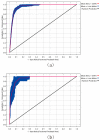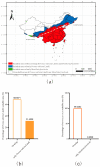Prediction of the Potential Distributions of Prunus salicina Lindl., Monilinia fructicola, and Their Overlap in China Using MaxEnt
- PMID: 36836304
- PMCID: PMC9963034
- DOI: 10.3390/jof9020189
Prediction of the Potential Distributions of Prunus salicina Lindl., Monilinia fructicola, and Their Overlap in China Using MaxEnt
Abstract
Prunus salicina Lindl. (P. salicina) is an essential cash crop in China, and brown rot (BR) is one of its most important diseases. In this study, we collected geographic location information on P. salicina and Monilinia fructicola (G. Winter) Honey (M. fructicola), one of the BR pathogenic species, and applied the MaxEnt model to simulate its potential suitable distribution in China. There have been discussions about the dominant environmental variables restricting its geographical distribution and their overlap. The results showed that the mean temperature of the coldest quarter, precipitation of the warmest quarter, precipitation in July, and minimum temperatures in January and November were the main climatic variables affecting the potential distribution of P. salicina, while the coldest quarter, precipitation of the driest month, precipitation of March, precipitation of October, maximum temperatures of February, October, and November, and minimum temperature of January were related to the location of M. fructicola. Southern China had suitable conditions for both P. salicina and M. fructicola. Notably, the overlap area of P. salicina and M. fructicola was primarily located southeast of 91°48' E 27°38' N to 126°47' E 41°45' N. The potential overlap area predicted by our research provided theoretical evidence for the prevention of BR during plum planting.
Keywords: brown rot; distribution prediction; ecological modelling; environmental variables; pathogenic microorganism.
Conflict of interest statement
The authors declare no conflict of interest.
Figures








Similar articles
-
[Prediction of suitable habitats of Phlebotomus chinensis in Gansu Province based on the Biomod2 ensemble model].Zhongguo Xue Xi Chong Bing Fang Zhi Za Zhi. 2025 Jun 6;37(3):276-283. doi: 10.16250/j.32.1915.2024223. Zhongguo Xue Xi Chong Bing Fang Zhi Za Zhi. 2025. PMID: 40730525 Chinese.
-
Signs and symptoms to determine if a patient presenting in primary care or hospital outpatient settings has COVID-19.Cochrane Database Syst Rev. 2022 May 20;5(5):CD013665. doi: 10.1002/14651858.CD013665.pub3. Cochrane Database Syst Rev. 2022. PMID: 35593186 Free PMC article.
-
Evaluation of the environmental factors influencing the quality of Astragalus membranaceus var. mongholicus based on HPLC and the Maxent model.BMC Plant Biol. 2024 Jul 23;24(1):697. doi: 10.1186/s12870-024-05355-3. BMC Plant Biol. 2024. PMID: 39044138 Free PMC article.
-
Measures implemented in the school setting to contain the COVID-19 pandemic.Cochrane Database Syst Rev. 2022 Jan 17;1(1):CD015029. doi: 10.1002/14651858.CD015029. Cochrane Database Syst Rev. 2022. Update in: Cochrane Database Syst Rev. 2024 May 2;5:CD015029. doi: 10.1002/14651858.CD015029.pub2. PMID: 35037252 Free PMC article. Updated.
-
The clinical effectiveness and cost-effectiveness of enzyme replacement therapy for Gaucher's disease: a systematic review.Health Technol Assess. 2006 Jul;10(24):iii-iv, ix-136. doi: 10.3310/hta10240. Health Technol Assess. 2006. PMID: 16796930
Cited by
-
Prediction of Suitable Habitat Distribution of Cryptosphaeria pullmanensis in the World and China under Climate Change.J Fungi (Basel). 2023 Jul 11;9(7):739. doi: 10.3390/jof9070739. J Fungi (Basel). 2023. PMID: 37504728 Free PMC article.
-
Occurrence Regionalization of Kiwifruit Brown Spot in Sichuan.J Fungi (Basel). 2023 Aug 31;9(9):899. doi: 10.3390/jof9090899. J Fungi (Basel). 2023. PMID: 37755007 Free PMC article.
References
-
- Statistics Department of the World Food and Agriculture Organization Crops and Livestock Products. [(accessed on 30 September 2022)]. Available online: https://www.fao.org/faostat/en/#data/QCL.
Grants and funding
LinkOut - more resources
Full Text Sources

